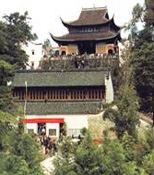
The Hundred Year Palace (Baisui gong)
Bai Sui Palace (Bai Sui Gong) lies on the summit of the eastern peak. It was originally known as the Zhai xing temple, but was later given its present name after a monk, Wu Xia, who lived on the mountain for the last time of his life.
Wu Xia was a devout Buddhist monk who lived during the sixteenth century. After visiting the temples in both Wu Tai shan and E Mei shan, the wise monk, who is said to have compiled the Hua yang Sutras (written in gold dust and his own blood), eventually settled in the Jiu hua shan area until his death at the venerable age of 126. With his hermitic lifestyle, Wu Xia was only discovered three years after his death, apparently perfectly preserved. The amazed locals immediately recognized the signs of Buddha hood, and so changed the name of the temple in accordance with the age of this monk’s ancient frame.
Emperor Chong zheng of Qing Dynasty (1644-1911 AD) heard about this religious icon, and had the tiny body of Wu Xia covered with gold leaves and placed in the temple. Imperial favors were also granted, allowing for the expansion of the temple to the fourth largest in Jiu hua shan. Today the body can still be seen in praying position.
|


